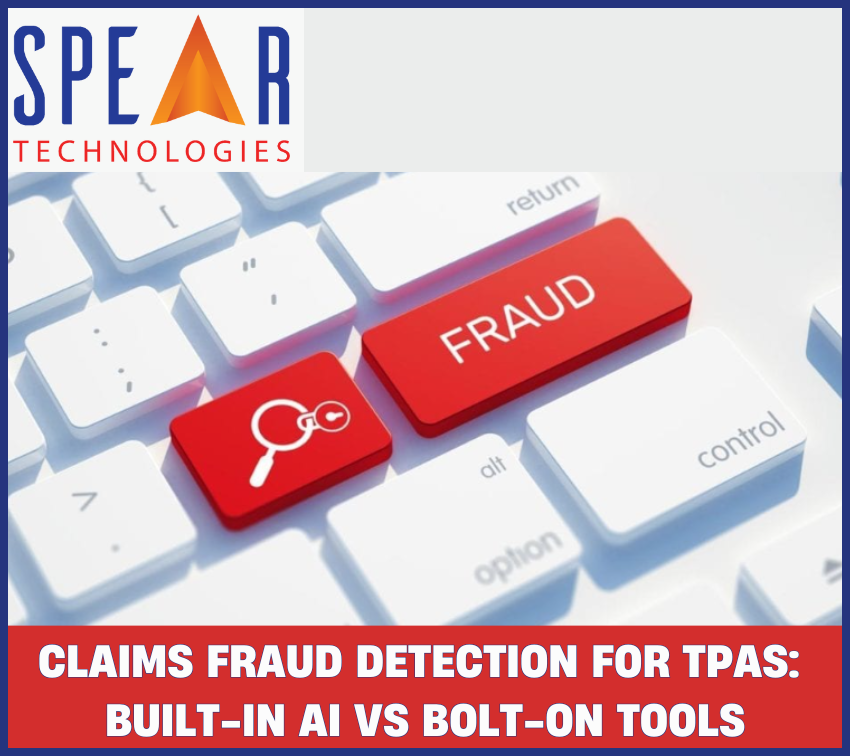Claims Fraud Detection for TPAs: Built-In AI vs Bolt-On Tools

For Third-Party Administrators (TPAs), fraud is more than a compliance issue—it’s a profitability and reputation challenge. Detecting fraudulent activity early can mean the difference between minimal loss and significant claims leakage. In today’s competitive market, TPAs can’t afford to rely solely on manual processes or outdated tools to manage fraud risk.
That’s why many are asking: Should fraud detection be built directly into your Claims Management Software—or bolted on as a separate tool?
In this article, we’ll examine how native fraud detection capabilities within a modern Claims Management System give TPAs a proactive edge in managing risk, preventing leakage, and protecting client trust.
Why Fraud Detection Matters More for TPAs
TPAs handle claims on behalf of insurers, self-insured organizations, and public entities—each with unique compliance, cost control, and transparency requirements. Fraudulent claims erode client confidence, inflate loss ratios, and put your reputation at risk.
With Third-Party Administration Software that includes built-in AI-driven fraud detection, TPAs can:
- Flag suspicious claims at first notice of loss (FNOL)
- Use Risk Assessment for Insurance to assess exposure in real time
- Reduce claims leakage through early intervention
- Improve adjuster efficiency with AI-assisted decision-making
When your fraud detection lives inside the TPA System you already use, it becomes a seamless part of the workflow—not a separate, siloed process.
Built-In AI: A Proactive Approach to Fraud
Modern Claims Management Solutions equipped with Accessible AI don’t just automate; they analyze claims patterns, compare them against historical data, and alert adjusters to anomalies—before the claim progresses too far.
Advantages of built-in AI fraud detection include:
- Faster Identification: AI evaluates every claim automatically, reducing the chance of missed red flags.
- Contextual Insights: Information from across the Claims Management Software is analyzed in real time.
- No Data Silos: All claim information, investigation notes, and fraud alerts live in one Third-Party Administration System.
- Continuous Learning: Models adapt over time to evolving fraud schemes.
Built-in AI is especially powerful for TPAs serving public entities, where Risk Assessment Insurance requirements are strict, and every decision is subject to scrutiny.
Bolt-On Tools: Reactive, Not Integrated
While bolt-on fraud detection solutions can work, they typically require additional integrations, data transfers, and separate dashboards. This creates:
- Lag in Response Time: Fraud signals may be identified after payments have already been made.
- Higher Costs: Licensing and maintaining a separate Claims Automation Software tool adds expense.
- Workflow Disruption: Adjusters must switch between systems, slowing productivity.
- Incomplete Visibility: Not all claims data is captured in one place, limiting the accuracy of fraud risk scores.
Bolt-on tools can still be valuable in specific cases, but they often lack the operational efficiency and proactive protection of embedded AI.
Fraud Detection as a Core Feature of TPA Technology
When evaluating Top Insurance Core Platforms, TPAs should prioritize those that make fraud detection part of their foundational capabilities. Look for Third-Party Administration Solutions that include:
- AI-driven Claims Automation Software for FNOL triage
- Automated fraud scoring on every claim
- Real-time alerts to adjusters and managers
- Integration with Claims Leakage Prevention Solutions
- Configurable rules to align with client-specific Risk Assessment for Insurance criteria
These capabilities don’t just reduce fraud—they position your TPA as a strategic partner in protecting client resources.
Accessible AI That’s Purpose-Built for TPAs
AI in fraud detection works best when it’s not a “black box.” Accessible AI in a TPA Software platform ensures:
- Business users can interpret and act on AI findings
- Fraud alerts are clear, not just technical scores
- Adjusters can provide feedback to improve accuracy
- Compliance teams can trace the reasoning behind each flag
This transparency is critical for TPAs working with public entities, self-insured groups, and high-accountability sectors.
SpearClaims™: Fraud Detection Built In
SpearClaims™ is a next-generation Third-Party Administration System designed to integrate fraud prevention directly into your claims process. With features like:
- AI-powered fraud scoring on every FNOL
- Real-time anomaly detection for faster intervention
- Configurable rules for industry-specific risk factors
- Complete integration into your Claims Management Solution—no bolt-on needed
- Comprehensive audit trails for compliance and oversight
This built-in approach allows TPAs to stop fraudulent claims before they drain resources, all while improving client confidence.
Conclusion: Integration Wins in the Fight Against Fraud
Fraud prevention isn’t a side project—it’s a core function of a high-performing TPA. By choosing a Third-Party Administration Solution with embedded, Accessible AI-powered fraud detection, TPAs can:
- Identify and stop fraud earlier
- Reduce leakage and protect loss ratios
- Meet strict Risk Assessment for Insurance requirements
- Improve adjuster productivity and decision-making
In the choice between built-in AI and bolt-on tools, integration offers faster, smarter, and more cost-effective protection.
Your clients deserve a TPA System that doesn’t just process claims—it protects them.
Ready to see how SpearClaims™ helps TPAs better serve public entities?
Schedule a Demo today and discover the TPA Solution that empowers smarter claims outcomes—backed by the industry’s most advanced Claims Management Software.
Request Pricing to see how SpearClaims™ delivers the enterprise grade insights TPAs need— for a fraction of the enterprise cost.



